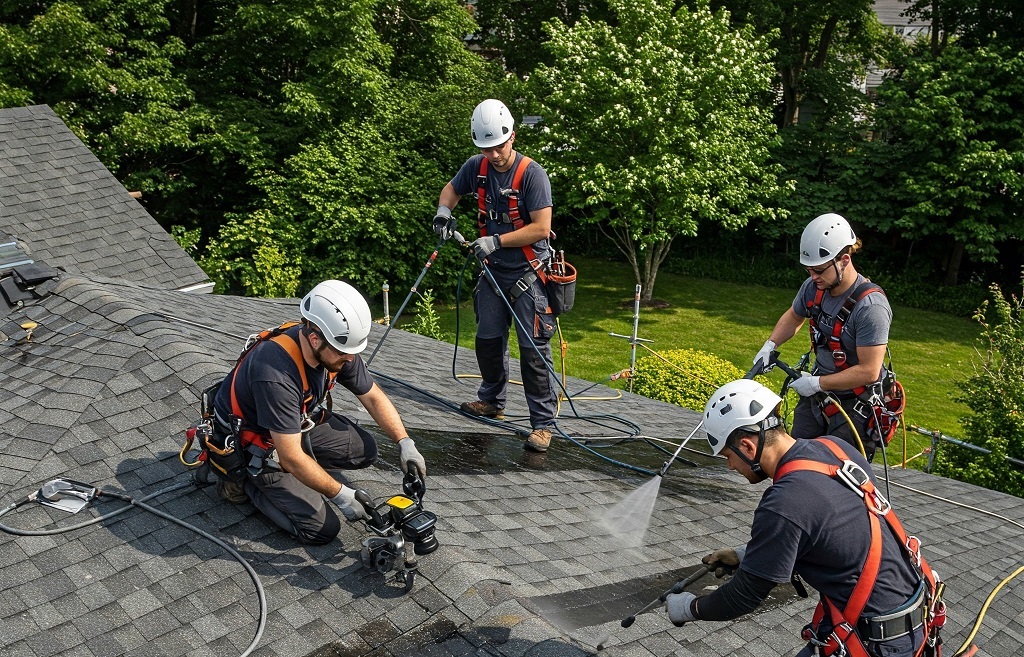Key Takeaways
- Proper roof maintenance can significantly enhance the lifespan of your roof.
- Regular inspections can help identify early signs of damage.
- Different roofing materials require specific maintenance approaches.
- Safety should be a priority while performing roof maintenance tasks.
Roof maintenance is a foundational aspect of home care that often goes overlooked until problems arise. A well-maintained roof not only enhances your home’s curb appeal but also guarantees the safety and comfort of its inhabitants against harsh weather conditions. By engaging in regular maintenance practices, homeowners can significantly lessen the likelihood of expensive repairs and extend the roof’s lifespan. This becomes particularly crucial when considering roof cleaning and upkeep across various materials such as shingles and tiles. Such tasks are essential not just for aesthetics but for the operational efficiency of the roofing system over time.
This comprehensive guide will delve into the myriad reasons why maintaining a roof should be a top priority for homeowners. It will outline the signs indicating your roof requires attention, discuss the different maintenance strategies for various roofing materials, and provide practical advice on scheduling regular inspections. With insights for both DIY enthusiasts and those considering professional services, the guide reflects how proactive care can result in a well-preserved, durable roof.
Why Roof Maintenance Matters
Regular roof maintenance, including pressure washing, is about more than just aesthetics; it’s integral to your home’s structural health and energy efficiency. A study by the National Roofing Contractors Association reveals that roofs typically last 20 years, but regular maintenance can extend that by another decade. This proactive care, including pressure washing to remove debris and mold, can prevent leaks, mold growth, and isolated damage patches from spreading. Maintenance ensures that minor issues are addressed before they become larger, costlier problems, thereby preserving the home’s value and safety. The savings in avoiding premature roof replacements or major repairs can be considerable, proving the value of regular roof assessments and upkeep.
Signs Your Roof Needs Attention
Identifying early signs that your roof needs repair is critical for maintaining its integrity. Look for telltale indicators such as curled or missing shingles, which often suggest weather damage or age-related wear. Other warning signs include water stains on ceiling tiles and walls, indicating leaks that can lead to mold and mildew if not resolved. Granules in the gutters are a sign that shingles are breaking down and may need to be replaced. Timely recognition and response to these indicators can prevent more extensive damage, safeguarding both your home and your family’s wellbeing.
Different Maintenance Approaches for Varied Roofing Materials
Different roofing materials require customized maintenance plans to address their unique properties and vulnerabilities. Asphalt shingles, for instance, need regular debris removal to prevent moss growth, while metal roofs benefit from annual rust checks and paint touch-ups. Tile roofs require a gentle approach; cracked or broken tiles should be replaced to maintain their waterproofing properties. Understanding these differences helps apply the right techniques and treatments, ensuring long-term durability. For a detailed understanding, consulting a roofing materials guide is invaluable.
Scheduling Regular Inspections
Establishing a routine inspection schedule is paramount in preventing undetected issues from escalating into major repairs. It is advisable to inspect your roof at least twice a year—in the spring and fall—to identify any damage that might have occurred due to seasonal shifts. During these inspections, consider hiring a professional to ensure a comprehensive evaluation, especially after severe weather conditions like storms or heavy snowfall. Professionals bring expertise in spotting subtle problems that might go unnoticed by untrained eyes.
Essential Tools for Roof Maintenance
Equipping yourself with the right equipment can simplify roof maintenance tasks and boost safety. A sturdy ladder, sufficient safety harness, caulking gun, and proper cleaning brushes are indispensable for effective maintenance. These tools not only keep you safe but also make the task less daunting and more efficient. An essential toolkit guide can provide a detailed breakdown of each tool’s use and importance, ensuring you’re prepared to tackle any maintenance issue that arises.
Safety Tips When Working on Roofs
Safety must always be your top priority when working at heights. Never work on a roof solo; always have someone nearby to assist or call for help in an emergency. Use a harness for additional security and minimize reaching too far from a ladder’s center for stability. Evaluate weather conditions before planning any maintenance—avoid working on wet or icy roofs. Secure the ladder on a solid, even base, and follow proper procedures to protect yourself and any helpers involved during the maintenance process.
Professional Services vs. DIY: Finding the Right Balance
There is merit in both professional roofing services and the DIY approach, each offering unique advantages. Professionals are equipped with the right knowledge, tools, and safety training to manage complex roofing issues effectively. However, for simpler tasks like gutter cleaning or visible shingle replacement, a hands-on approach can provide substantial cost savings and satisfaction with a job well done. Ultimately, the decision should be based on the task complexity, personal experience, and comfort with handling roofing hardware.
Sustainable Options for Roof Care
As homeowners grow more environmentally conscious, integrating sustainable practices into roof maintenance can have considerable benefits. Opting for eco-friendly cleaning solutions and materials characterized by durability and recyclability is one way to reduce environmental impact. Additionally, consider implementing energy-efficient modifications such as reflective coatings or solar panels. These not only contribute to a healthier environment but also provide long-term financial savings by reducing energy costs. Embracing sustainability is an investment in the future of both your home and the planet.


